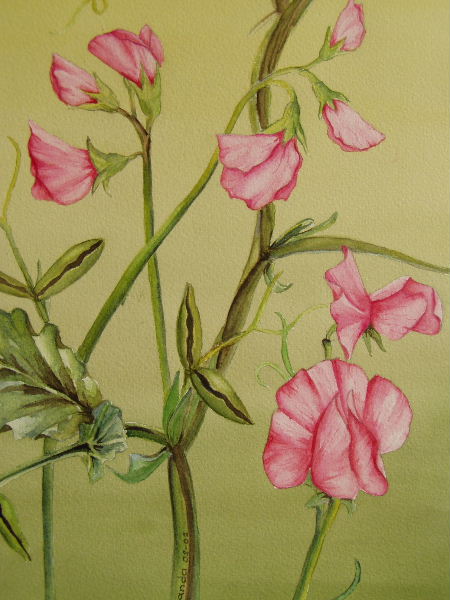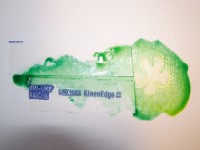 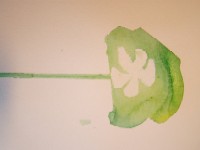 One reason to cover parts of your artwork may be that you want color gradients to flow behind a subject, for example, a sky behind a tree. It may also be that you want certain parts to remain pure white because they represent the highlights. Below are the most common materials listed that you can use for the covering technique in watercolor. One reason to cover parts of your artwork may be that you want color gradients to flow behind a subject, for example, a sky behind a tree. It may also be that you want certain parts to remain pure white because they represent the highlights. Below are the most common materials listed that you can use for the covering technique in watercolor.Removable Masking Techniques:: For straight lines, it is best to use tape or film. With masking fluid, you can create all kinds of irregular shapes. |
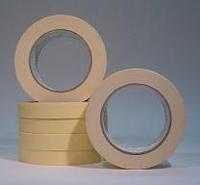 Crepe Masking Tape: Can only be used on a dry surface. The tape can leave adhesive residues or damage your paper when removed, especially if left on your artwork for too long. However, it adheres excellently to paper and provides good coverage. Crepe Masking Tape: Can only be used on a dry surface. The tape can leave adhesive residues or damage your paper when removed, especially if left on your artwork for too long. However, it adheres excellently to paper and provides good coverage. |
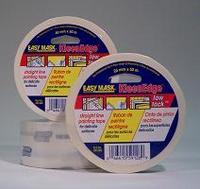 Kleenedge Masking Tape: Can only be used on a dry surface and leaves no adhesive residues. The downside of this tape is that it doesn't always stay in place very well. Kleenedge Masking Tape: Can only be used on a dry surface and leaves no adhesive residues. The downside of this tape is that it doesn't always stay in place very well. |
 Scotch Removable Magic Tape: is easy to remove and leaves no adhesive residues. The downside is that the tape is not very wide. Scotch Removable Magic Tape: is easy to remove and leaves no adhesive residues. The downside is that the tape is not very wide. |
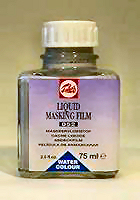 Art Masking Fluid or Liquid Masking Film: This is used to mask areas on the watercolor paper to repel watercolor paint. This product is available in various brands. It comes in both colorless and light gray or yellowish tints. Tinted masking fluids are often preferred because it is easier to see where the film has been applied. Art Masking Fluid or Liquid Masking Film: This is used to mask areas on the watercolor paper to repel watercolor paint. This product is available in various brands. It comes in both colorless and light gray or yellowish tints. Tinted masking fluids are often preferred because it is easier to see where the film has been applied.tip: Use an old brush to apply this and clean it immediately after use. By first applying some liquid soap to the brush, the masking fluid comes off better, and you can use the brush longer. |
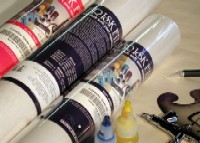 Frisk Film Masking Film. This is a transparent lightly adhesive masking film that you can cut into the right shape yourself. Ideal for precise work on paper. This is mainly used for airbrush techniques. It's not always easy to come by. Also, check model shops, as it's also used there.. Frisk Film Masking Film. This is a transparent lightly adhesive masking film that you can cut into the right shape yourself. Ideal for precise work on paper. This is mainly used for airbrush techniques. It's not always easy to come by. Also, check model shops, as it's also used there.. |
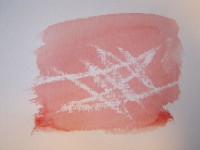  Permanent Masking Techniques: Permanent Masking Techniques:You can cover parts of your work with wax. Wax is available in various forms. You can buy sticks used for batiking, for example. You can also cover areas with a layer of simple (white) candle wax, grease crayon, oil pastel, or crayon. You cannot remove this from the paper. However, the effect of this technique is completely different from that of masking fluid or tape. Especially when using paper with a coarse texture. The deeper parts of the paper are not affected when applying the wax, so they do absorb pigment. Depending on your paper, this creates a kind of grainy texture. So, the paper is not evenly covered. |
 Permanent Masking Medium: This is used to mask areas on the paper but cannot be removed. You can mix it with watercolor paint to get an even tint. You can also use this to fix mistakes. Permanent Masking Medium: This is used to mask areas on the paper but cannot be removed. You can mix it with watercolor paint to get an even tint. You can also use this to fix mistakes. |
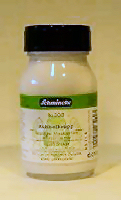 Liquid Frisket is used to mask areas on the paper so that they repel watercolor paint. The effect is actually the same as with wax. Liquid Frisket is used to mask areas on the paper so that they repel watercolor paint. The effect is actually the same as with wax. |
Welcome at To be defined
| Welcome at To be defined, a website filled with creativity. Here you will find numerous manuals in words and images on various subjects. On this page you can only see a selection. Choose from the menu on the left for more articles on your favorite topic. |




